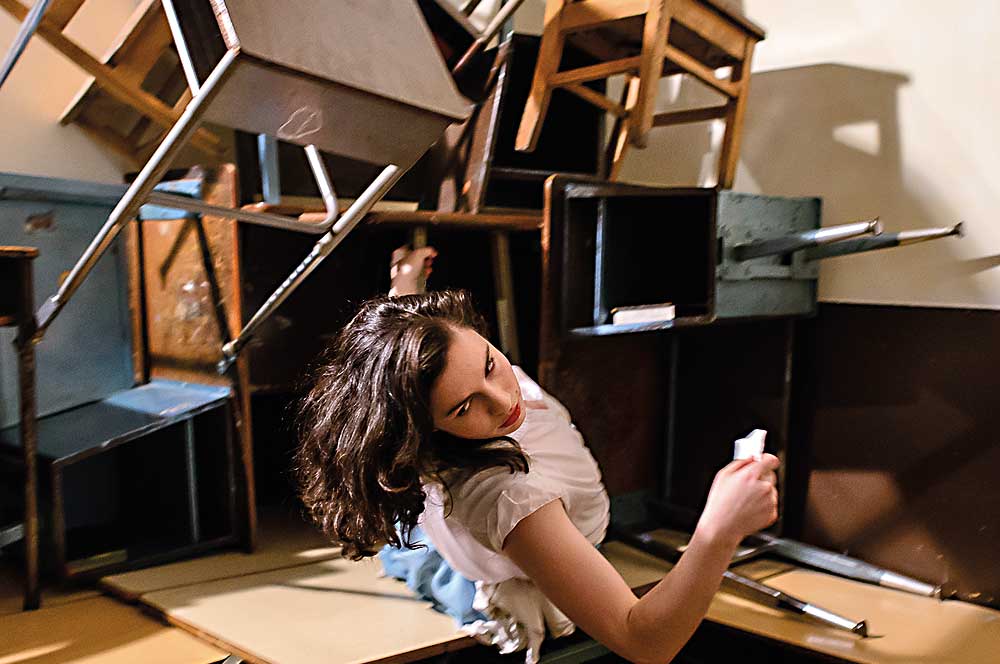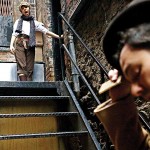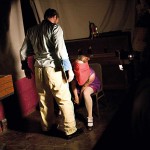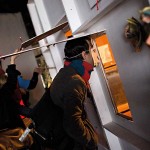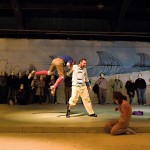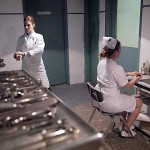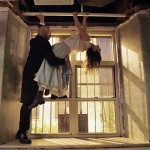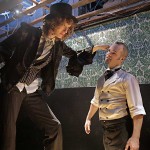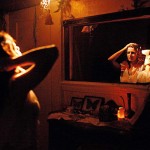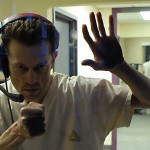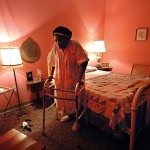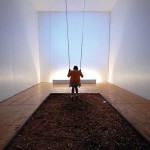The killer had fled upstairs. The victim, whose arms had been caught in his coat when he died, had blood seeping from his neck and chest. His body was soon carried off, and only the witnesses and the police officers were left.
And me. I was there at the scene, pen and pad in hand, seeking out descriptions of the killer. “Was he skinny or fat?” I asked the crowd standing around me. “Skinny!” they replied unanimously. “It was the barber,” volunteered one witness. “He was wearing suspenders,” another chimed in. “He had on a bowtie.” “He had brown hair, was in his thirties, 5’6″.” “He had a mustache.”
“How many shots?” I asked. “There were two shots.” “Three shots.” “Four shots.” “Somebody had a beef with his son.” I scribbled fast and a little illegibly. What was I collecting all this info for? Had Diep Tran, theatre reporter, suddenly found a new beat to cover?
Fortunately not. I was an actor in a play, in the role of a police sketch artist, asking the audience to describe the killer. For the record, I am not a performer (though, perhaps ironically, my drawing skills are fairly strong).
The play—Speakeasy Dollhouse, created by New York City–based artist Cynthia von Buhler and currently running on Manhattan’s Lower East Side—was interactive. I, as an actor, shared space with the audience for two-and-a-half hours. They could ask me questions and I could discuss my backstory, my occupation, my thoughts about the drama’s unfolding plot; I could ask them where they’re from and, of course, what the killer looked like. And they were, to a person, all game to play along.
“We now live, it seems, in Thespian Nation,” Washington Post theatre critic Peter Marks recently opined. “It’s nothing short of amazing, how primed folks are (and not just the young ’uns) to shed their anonymity.” Judging from my experience at Speakeasy Dollhouse—and from a recent spate of audience-immersive productions that are garnering attention at a wide range of U.S. theatres and related venues—Marks is correct. The genre, which has experienced an eruption in popularity in recent seasons, is variously known as immersive, interactive or site-specific, though the lines blur between these monikers depending on the show in question.
The effect, as I learned firsthand, is akin to a real-life “Final Fantasy”–esque role-playing game where the viewer is completely enclosed in the world of the play and becomes an active participant. In these works—mounted by groups like Dog & Pony Theatre Company in Chicago and a similarly named company in Washington, D.C.; We Players of San Francisco; Bricolage Production Company of Pittsburgh; Third Rail Projects of New York City; and, most famously, the British company Punchdrunk, generators of the wildly popular Macbeth takeoff Sleep No More—you may find yourself sipping tea at the Mad Tea Party, dancing at prom or hitting a stormy battlefield alongside a regiment of characters. California’s La Jolla Playhouse will devote a full-scale festival program, called Without Walls (WoW), to interactive, site-specific performance in October.
I have to admit, when creator/director von Buhler of Speakeasy Dollhouse offered to put me in her show as part of my research for this story (in her words, “This is immersive! You gotta immerse yourself!”), I was not primed. My biggest surprise was that, as Marks predicted, not only did my audience witnesses manage to give me accurate descriptions of the killer (aside from one guy who tried to trip me up by saying the killer had a mustache when he didn’t), they were also willing to measure corpses, talk to faux police officers and correctly I.D. the killer at his mock trial. Von Buhler considers the audience almost as important to the show as the actors. By entering the bar, the patrons populate the show’s 1930s world. “I need people there to be the party to make it work,” she says during an afternoon interview in her midtown apartment. “Basically they’re unpaid actors!”
Speakeasy Dollhouse is mounted at a real-life bar in Lower Manhattan called the Back Room, where the audience can wander freely into different rooms—which include an apartment, a coroner’s office, an alleyway, a barber shop, a bakery, and a bar/lounge where drinks are served in teacups, a live band plays, and both actors and audience are dressed in Prohibition-era style. There is always something happening in each room. The overarching story is a reenactment of the death of von Buhler’s grandfather Frank Spano (played by Russell Farhang), who owned a speakeasy in New York City during Prohibition. He was murdered by his neighbor, barber John Guerrieri (Silent James), who may or may not have been in cahoots with mobster Dutch Schultz (Michael McMillan).
In this show, audience and actors are free to converse, but the role of the audience varies within the genre. Sometimes ticket-buyers become voyeurs with a close-up view of the action; at other times the audience has an active hand in dictating the action, choosing the narrative they want to see or the characters they want to follow around for a night. But the motive is consistent: to give agency so audiences can, to borrow a phrase, choose their own adventure.
Doing away with the fourth wall isn’t new. The forebears of immersive theatre include Augusto Boal’s Theatre of the Oppressed and Richard Schechner’s Performance Group (in the latter’s production of Dionysus in 69, the audience participated in a bacchanal with the actors, where dancing and orgiastic interplay were part of the fun). And audience immersion and interactivity have always been mainstays of haunted houses and historical reenactment sites.
But the genre now seems to have entered the mainstream. Punchdrunk’s touchstone Sleep No More, currently playing an open run at the McKittrick Hotel (created for the show) in New York’s Chelsea neighborhood, enacts almost wordless shards of the Scottish Play in 93 rooms, spread out across six floors; the audience can explore the space at will, chase characters around and touch the props. It was brought to the U.S. by nontraditional theatre creator and producer Randy Weiner, who first mounted it in Massachusetts before taking it to New York, under the aegis of his production company Emursive.
Weiner is also the creator of The Donkey Show, A Midsummer Night’s Dream set in a nightclub, currently in a late-night open run at American Repertory Theater in Cambridge, Mass., where his wife, Diane Paulus, is artistic director. “I think all of us were interested in doing something that was unlike anything else,” he says of his infatuation with Punchdrunk’s creation. “As human beings, what do we long for? Surprise, something unique, something that feels secret. Sleep No More feels like an event.” An event, moreover, that defies description. “I can show you many things and you’ll still have no idea what it feels like to go in there.”
While the phenomenon of letting the audience into the world of the play has exploded internationally (so much so that Charlotte Higgins of London’s Guardian wrote a blog post begging, “For god’s sake, bring back the fourth wall. And seats.”), its popularity stateside is more underground, confined to a handful of cities and encouraged by local buzz. “It’s one of the places where America is behind,” believes La Jolla Playhouse artistic director Christopher Ashley. “A lot of the energy of the regional theatre movement went into creating, in every city, a temple of art, a beautiful theatre. Now there is a next generation of impulse, which is: Let’s reinvent where theatre happens. This is an impulse that’s not about creating a building, but about exploring preexisting architecture and landscapes.”
It’s a theatrical equivalent of the chicken-and-egg question: What comes first, the show or the venue? For Ava Roy, founding artistic director of We Players in San Francisco, which specializes in mounting classic texts in historic locations, the place dictates the story.
When We Players was invited to perform in Angel Island State Park, located in the San Francisco Bay, Roy scoped out the space and did in-depth research before choosing to mount The Odyssey. “There’s 100 years of military presence on the island, and it’s nicknamed the Ellis Island of the West, so there’s a very strong immigration history,” she explains. “Those histories connected me to Odysseus, to the theme of going away and having an experience and being transformed.”
Adapted by the ensemble and directed by Roy, The Odyssey ran in spring 2012 and was spread across the entire 800-acre island: Olympus was at the top of a 60-foot cliff, Hermes made his entrance on a golden speedboat, the abandoned hospitals on the site became the House of the Dead, and Scylla and Charybdis formed an obstacle course for the audience. The entire journey took spectators six hours to walk through, guided by Telemachus, who was looking for his father and spoke freely with the group.
Though the experience was carefully curated, with viewers herded from scene to scene, individual vantage points made for experiential differences. “Even though you’re moving as a group, the spaces we chose were multidimensional,” Roy notes. “I’m staging things way off in the distance, on a cliff above your head. We’re challenging audiences to expand their awareness and perspectives and look above and behind them, below them, off in the distance. People can choose their perspectives, whether they get close to the actor or move farther back.”
Not every immersive show needs to take its audience on a walk. Breaking the fourth wall can be as disconcertingly simple as making the audience stand up from their seats and disinfect the walls of the theatre. That’s one of the tasks that some lucky participants get to take on in dog & pony dc’s devised play A Killing Game. That show “works best as a three-quarter thrust experience, where the front row is level with the playing space,” specifies show director and co-writer Colin K. Bills.
In A Killing Game, based on an Ionesco play (with overtones of War of the Worlds and the Fluxx card game), a plague has hit the city and no one is immune. Audience members are given a stack of cards, which indicate what tasks they are supposed to do for each round, and a cue for when they’re expected to die. Spectators earn points for helping to diagnose the disease, for disinfecting the theatre and for how well they die. At one performance, a male patron crawled across the whole stage as he died. He probably got a lot of points for that.
The play is modeled after a game show—at the end of the night, the person who has the most points wins. As Bills puts it: “The best way to live and celebrate life is to look death in the face and play the game of life to the fullest, as hard and as joyfully as possible.”
A Killing Game originally ran in late 2012, and played in May and June at the Cincinnati Fringe Festival in Ohio; its next stop is the Capital Fringe in D.C. in July. For d&pdc’s next show, Toast, currently in development, the company wants to take audience integration even further by having attendees co-create the narrative. “Everything we do, it can’t complete itself without the audience contributing to the performance,” says Bills. “In some ways, they become a bigger element of the performance than the ensemble.”
Some immersive works contain multiple narrative strands happening at once. If there are many locations within a venue and the action is happening simultaneously in different rooms, the location of each essential action needs to be mapped out, and the travel time between rooms need to be taken into account. In the script for As Told by the Vivian Girls—an adaptation from Dog & Pony Theatre Company (no relation to d&pdc) of the 15,000-page novel In the Realms of the Unreal, written and illustrated by Chicago outsider artist Henry Darger—each scene was divided into sub-scenes, all of which were happening at the same time in seven different locations. Vivian Girls ran in 2008 and is being remounted in 2014.
The story follows the five Vivian sisters, chronicling their escape from slavery and their revolt against their oppressors. To figure out a coherent structure, Vivian Girls creator Devon de Mayo, who devised the show with the Dog & Pony ensemble, originally started with a map that contained her favorite paintings from Darger’s book and determined, “Where do they fall in the trajectory of the story? I then took each character and traced his or her journey—which place they are visiting, how they got there and who interacted with whom.”
When Dog & Pony entered the show’s venue, the 20,000-square-foot Theater on the Lake, and discovered how long it took to travel from room to room, they realized that the script’s male track (populated by the enemy generals) was slower than its female track (featuring the Vivian Girls). That was problematic because the two tracks needed to converge in a battle scene. “We had to write an additional scene for the Girls,” de Mayo notes, to facilitate the timing.
Vivian Girls was also more expensive than the new plays that Dog & Pony traditionally produces (they have staged plays by Sheila Callaghan and Noah Haidle). “In terms of physical material, you’re covering much more space,” says co-artistic director Krissy Vanderwarker, who supervised the show with Heather Rafferty and de Mayo. “And to fully inhabit a building, you’re going to need more actors, so you’ll have to pay more for them.” Vivian Girls had a cast of 15, not including the patrons, who—as in Sleep No More—wear masks (in this case, Vivian Girl masks).
You enter a room covered in hats. There are hats attached to the walls, piled up on the desks, in colors of black, brown, blue, red, green. Fabric spills out of drawers. The floor is strewn with crumpled pieces of paper. The Mad Hatter—tall and lithe and resembling a slightly manic Katharine Hepburn—rushes in, with an audience member whose arm is loaded with rolls of fabric. It’s just the three of you in the room.
“Are you here for a hat?” she inquires. You say yes and pick a blue one, wide-brimmed and with a gargantuan white feather. “That one? You sure?” she says. She places it on you and looks at your profile. “It does suit you.” She turns to your scene partner, giving her a fountain pen, an inkwell and a piece of stationery. “Do you take dictation?” She begins a letter: “Dear Mr. Carroll.”
Elizabeth Carena, who plays the Hatter in Then She Fell, a project of the New York dance-theatre company Third Rail Projects, spends a substantial portion of her time in scenes with only one or two people. Sometimes they don’t cooperate. “I’ve had someone take the inkwell and pour it all out onto his paper. And he just wanted a reaction from me,” she recalls during an interview in Brooklyn. “I continued the scene, and at the end, I folded up the sopping wet paper and I placed it in his hand and said, ‘You’re going to need that.’ This show isn’t about battling with the audience.”
Then She Fell—for which only 15 audience members are admitted at each performance—is directed, designed, written and choreographed by Third Rail founders and artistic directors Zach Morris, Tom Pearson and Jennine Willett. Based on Alice’s Adventures in Wonderland, Through the Looking-Glass and the real-life relationship between Lewis Carroll and Alice Liddell, the play is currently running through Sept. 29, with a possible extension, at a former parochial school in Brooklyn.
Each individual visitor to Then She Fell is led through the different rooms, spanning three floors, where the halls and lobby area are furnished like a period mental hospital. A nurse may lead you to a bedroom, where the White Queen will tuck you into bed and tell you a bedtime story; or you may paint the roses red with the White Rabbit; or you may brush Alice’s hair while she asks you about your first love. And you will also see the characters dance.
In intimate scenes such as these, performers need not play to the back of the house. “It requires us to have an ease that we would have in everyday life,” says co-creator Tom Pearson, who plays the White Rabbit, sans bunny suit. “It’s very cinematic. When the screen is right there in front of your face, it picks up everything. It’s the same when you’re in a room with someone.”
As in Then She Fell, a one-on-one experience for every audience member was offered in STRATA, a production mounted in summer 2012 by Pittsburgh-based Bricolage Production Company. The difference was that in each room, the STRATA visitor was given a choice of where to go next. The effect, though, is the same: Not every person followed the same track.
“We really wanted to address the homogenization of art, and theatre in general. When bringing an audience all at once into the same space, the audience gets cues from each other on how they’re supposed to respond,” says STRATA co-creator and Bricolage artistic director Jeffrey Carpenter. “Ultimately, the STRATA experience was about you, and it was so individualized that nobody had the same experience.”
The show ran, appropriately enough, in a former Bally Total Fitness. Each participant was put through a series of “refitnessing tests” in different rooms, in order to achieve “iConsciousness.” These tests included watching a series of steadily more intensely violent videos, dancing with an actress at a mock prom, and choosing one of three bottles presented by a monk.
“If you’re looking for a linear story, you might be frustrated,” Carpenter suggests. “There’s a beginning and an end, but within the middle, there’s a dream logic that connects one space to another; it doesn’t follow linearly. The piece was structured around these bigger ideas of titration, or loss, or the sacred, or the profane.”
Because the scene in each room depended on the actor(s) reading cues from the scene partner/audience member, there came a point when Carpenter and his creative team realized, “We were going to lose control over the performances because we couldn’t be there to shape a moment. So all of our work was done upfront, and we would meet every night and debrief. It became this whole other thing!”
If in proscenium theatre the playwright is king, then in immersive theatre the audience wears the crown. In order to get a full experience, a person attending an immersive show might need to sing for his or her supper by walking around, snooping through drawers, talking to actors, playing at dying—things that are not usually allowed in a proscenium house. And, in most cases, spectators will not see everything. They won’t visit all the rooms in STRATA or Then She Fell; they may not be in the alley when Frank gets shot in Speakeasy Dollhouse; they might not have arrived on the battlefield when the Vivian Girls are fighting their captors. They may not want to die in A Killing Game or catch the myriad of details on Angel Island during The Odyssey.
But for these shows’ creators, it does not matter. The priority is to be engaged and to have an experience. “I’m sure they don’t get everything, and that’s fine,” says von Buhler. “The point is to get pieces of it, have a good time and enjoy it. They can come back and do it again. I have people who have come to every show! They keep finding new things.”
Indeed, Speakeasy Dollhouse has been running since 2011 and keeps getting extended; it’s now playing through December. STRATA, Then She Fell and As Told by the Vivian Girls were the highest-selling shows in the history of their respective theatres. Seventy percent of the ticket-buyers for A Killing Game were under 45-ers, the Holy Grail of theatregoing demographics. And Sleep No Morehas entered popular culture, with cheat sheets, a “Gawker” how-to (for finding the nudity), a digital version created by Perrier, a fan Tumblr called “They Have Scorched the Snake” and assorted fan fiction.
Pearson attributes the rise in popularity of immersive theatre to an increasingly digital world. “Our craving for intimacy, connection and real experience when we go out to an event is a direct result of the fact that our lives revolve around virtual stimulation all the time,” he says. “When we go out and pay for an experience, we want it to be real, authentic.”
And what is more authentic than theatre where the actors and the set are close enough to touch? Roy likes to toss around the phrase “sensory apparatus” in her talk about We Players’s work. “We want you to experience the show with all of your senses activated,” she asserts. “We’re not just watching the actors and listening to the story—we’re feeling the wind, the sun, the rain. We’re smelling the rust of the site, or the fennel grass in the open fields. We’re becoming intimate participants with the environment.”
Theatre institutions have taken notice of the popularity of these nontraditional forms. Since 2011, La Jolla Playhouse has presented an annual series called Without Walls, focusing on site-specific works that utilize various levels of audience immersion. This year’s offering, Accomplice: San Diego, from Tom Salamon and Betsy Salamon-Sufott, originally set to close in April, has been extended to July 7. “I hope Without Walls can happen consistently enough that people consider it part of our core,” declares La Jolla’s Ashley. “I think this type of theatre is vital enough and exciting enough that it deserves to be part of La Jolla and other theatres in America.”
La Jolla is formalizing that commitment in its inaugural Without Walls Festival, running Oct. 3–6 and featuring site-specific, immersive works from national and international artists. Among the American presentations is a remount of the popular The Car Plays: San Diego from Los Angeles’s Moving Arts, in which teams of two can climb into five different cars and watch a 10-minute play in each car. In addition, Tom Dugdale is directing a version of Our Town that begins with the actors and audience sharing an outdoor meal together in a eucalyptus grove, from which the actors gradually ease their way into the play at the table. The last third of the play happens out in a field.
Ashley hopes to make the festival a biennial event, and to continue presenting a site-specific production annually. Rest assured, La Jolla will not be abandoning staged plays any time soon, but its adventurous A.D. is convinced that there is something irreplaceable about seeing a play in a eucalyptus grove, on a distant island, or in a former Bally Total Fitness. “There’s always going to be another play in another theatre with a seat facing the proscenium. But if you miss an occasion of site-specific theatre, you might never see something like that again.”
And if you do get that hot ticket—wear comfortable shoes.

